Tuesday, May 12, 2015
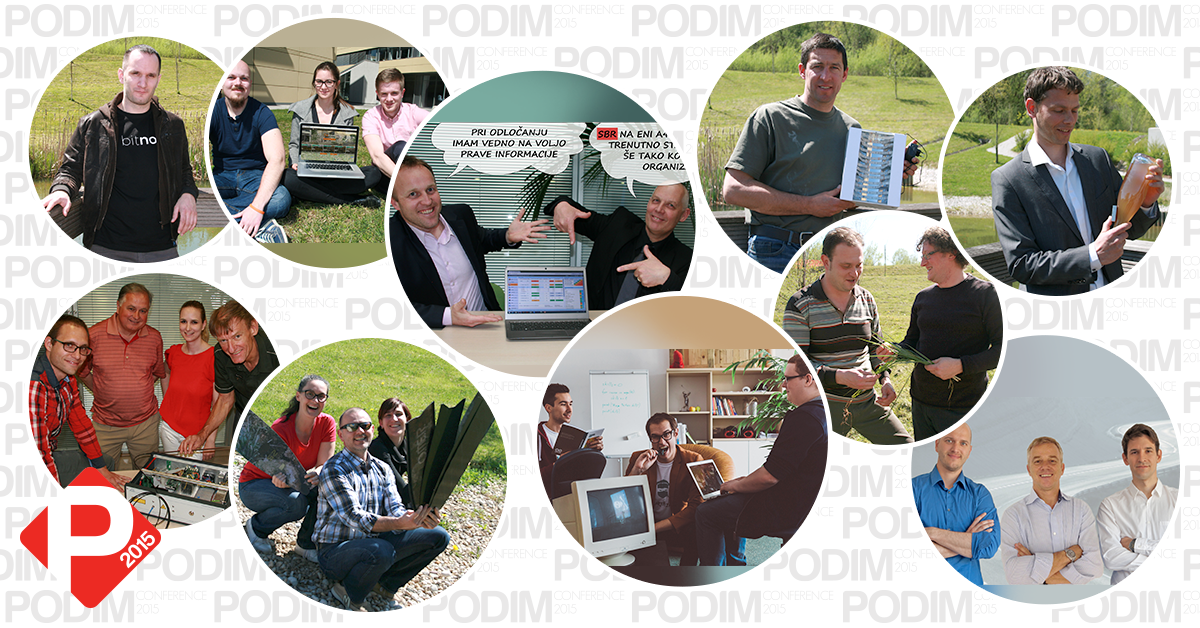
Announcing the semi-finalists of Start:up Slovenia 2015 competition!

102 start-up teams submitted the application form for the Start:up Slovenia 2015 competition and the P2 tender of the Slovene Enterprise Fund. In April, they pitched at demo days in front of 64 members of the committee that included investors, entrepreneurship experts and established entrepreneurs, and 10 teams with the best score made it into the semi-finals of the competition. A special committee of 11 members chose five semi-finalists. We will reveal them at the PODIM press conference on Wednesday, 13 May. The winner, who will receive awards, a statue and the flattering title “Slovenian Start-up of Year 2015”, will be announced under the spotlight of the evening ceremony. This marks the eight year of us ceremonially concluding the first day of the PODIM Conference, which is this year taking place for the 35th time.
The evaluation criteria
Start-up teams that submitted the form for the Start:up Slovenia 2015 competition and the P2 tender of the Slovene Enterprise fund, and pitched at demo days on 9 and 10 April, were evaluated in line with the so-called lean methodologies. We changed the evaluation criteria and evaluated the start-ups according to six key criteria:
The ten best ranked startups made it into the semi-finals of Start:up Slovenia 2015. Recently, we organised another round of personal pitches in front of a special expert committee that chose five best Slovenian startup companies – five competition finalists that will be revealed at the PODIM press conference on Wednesday, 13 May at 11 o’clock. We will announce which of the finalists will receive a crystal statue, the flattering title “Slovenian Start-up of the Year 2015” and other awards at the evening ceremony, thus triumphantly concluding the first day of the PODIM conference for the eighth year in a row.
All ten teams that made it into the semi-finals of the competition Start:up Slovenia based on demo days assessments are listed in alphabetical order:
1. BITNOT: Unlocking doors handsfree

The BITNOT team developed a method of handsfree unlocking, where a smartphone is used instead of a key. Their solution should prevent unpleasant and stressful situations when people forget their keys or they stand in front of their door while searching for the keys in big purses or bags. The solution is attached to a lock and when the individual approaches the door, the lock detects the mobile phone and unlocks.
The team sees its potential in the increasingly bigger accessibility and use of smartphones as well as in the big sales market of smart locks that will probably be worth around 3.6 billion dollars in 2019. The market of handsfree locks is still in the early stages. There aren’t a lot of competitors and the ones that do exist have one weakness – their solutions aren’t suitable for the European market.
Currently 20 users are testing the product, which is still being improved, because the team wishes to make the installation simpler and increase energy efficiency. They are planning for the battery to withstand being unlocked up to 3000 times. In the future, they are planning to support the Cota wireless charging system, with which battery charging will be simply forgotten. The team is planning a Kickstarter campaign in December, and to start sales in 2016.
Team members: Martin Koterle, Kristjan Ugrin
2. BIZSTART 86: Fluoro detector preventing contamination in laboratories
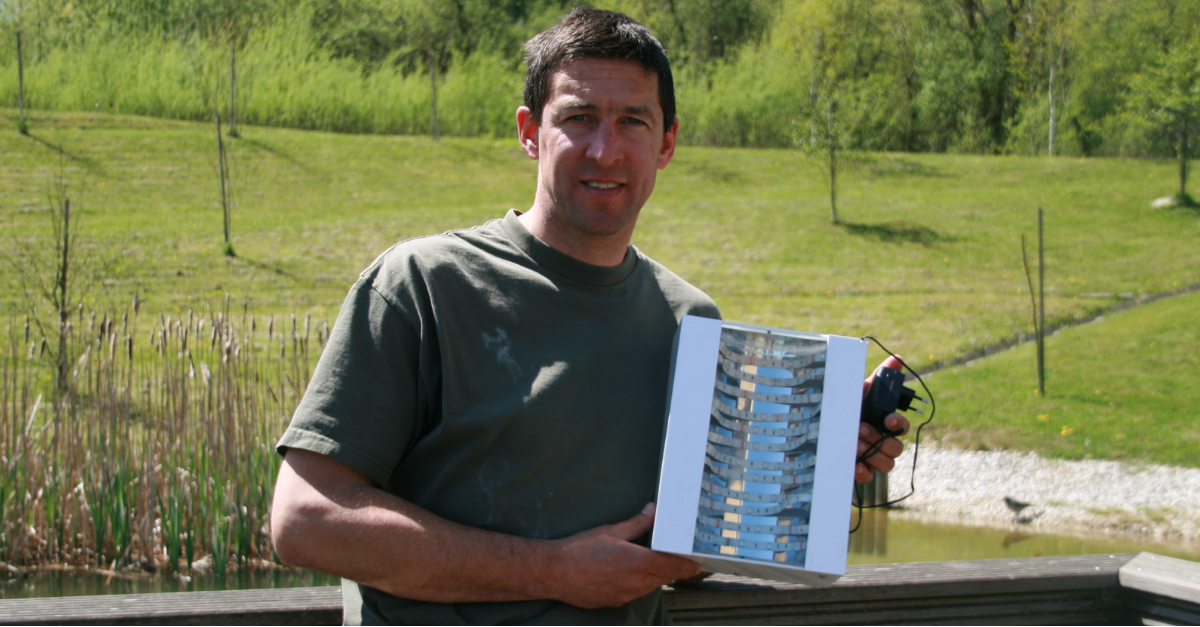
Contaminated lab equipment can cause wrong results and consequently additional costs because analyses have to be redone. The team sees the solution in a fluoro detector that could examine the equipment and detect any irregularities or impurities before doing the lab analysis. This would save time as well as money. The fluoro detector is thus a niche product in the form of a lab lamp and their solution is suitable for every laboratory doing fluorescence-based research.
The core competency is a complete market innovation and has a large global and market potential. The team is targeting the Slovenian market (also test market), the European and the global market (USA, Brazil, which is also a test market). The product doesn’t have any competition and is the first of its kind on the market. The early users will mostly be research labs in the fields of pharmacy, biochemistry, food industry, medicine, veterinary science…
This year, they are planning to further develop and test the product with customers (Slovenia, Brazil) as well as to plan sales in 2016 (domestic and EU market, entering the global market by the end of 2016).
Team members: Tina Šmuc, Andraž Balkovec, Robi Kopač, Henning Ulrich
3. INOVINE: MagYeast, solution for quick production of sparkling wine
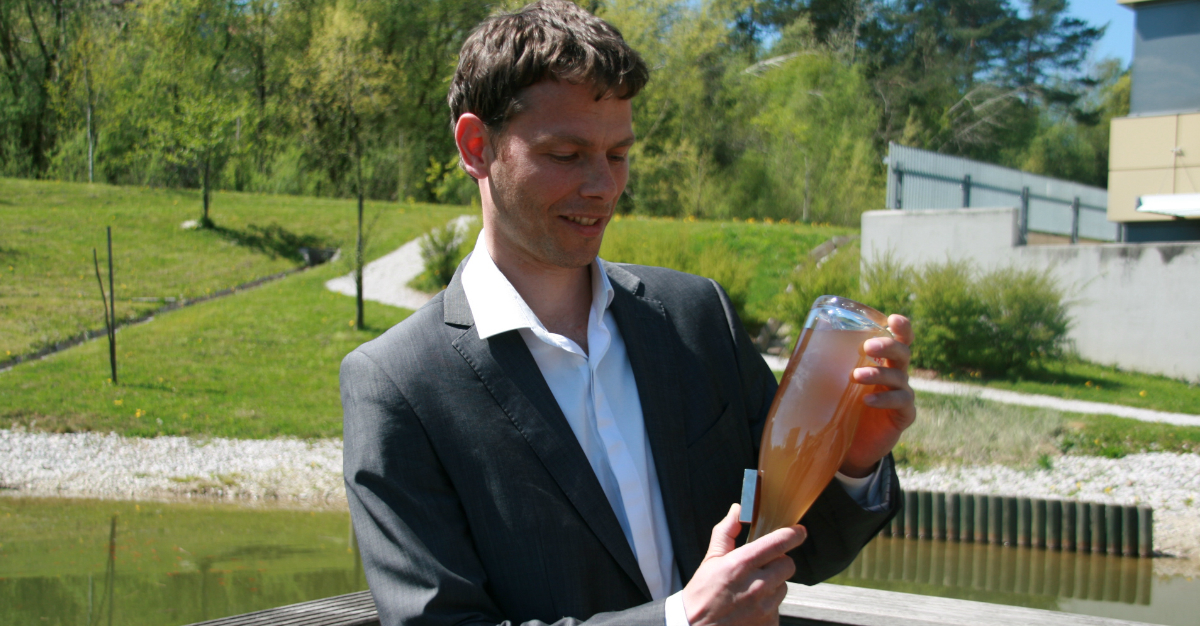
Production of high quality sparkling wines is demanding, expensive, time-consuming and inflexible, which is why excellent producers often face problems related to processing orders on time and delivering their sparkling wines to final clients. At the same time, producing high-quality sparkling wines can be an incredibly profitable activity that had the highest global growth in the beverage production industry in the past decade.
Company InoVine recognized its potential and opportunity mostly in shortening the time-consuming procedure of disgorging, which is a prerequisite for selling sparkling wines on the market. They have created an innovative solution for quick magnet separation of lees from the bottle, which shortens this procedure from a couple of weeks to mere 30 minutes.
This is the innovative solution MagYeast that can revolutionize the process of sparkling wine production, is environmentally-friendly, easy to use and doesn’t interfere with the final quality of sparkling wines. With simple integration into the production process, it saves sparkling wine producers time and money, and consequently increases the profitability and scope of their production.
Their potential clients are excellent global producers of high-quality sparkling wines, with whom the company already established contact, as well as other producers who wish to produce high-quality sparkling wines but currently produce sparkling wines of lower quality due to high production costs. Consequently they reach lower prices on the market and are mostly suitable for sales on the local market.
The company wants to obtain the position as an internationally established provider of high-tech solutions in the field of process engineering in beverage production. Their short-term goal is the development and commercialization of the MagYeast solution, which will be tested by early users this year already. For 2016, they plan to start marketing the solution, starting with the local and regional market, and expanding to the main global markets of sparkling wine a year later.
Team members: Marin Berovič, Uroš Pečaver, Sašo Gyergyek, Milan Vitas
4. KOINHAB: Coinhab – platform for collective construction
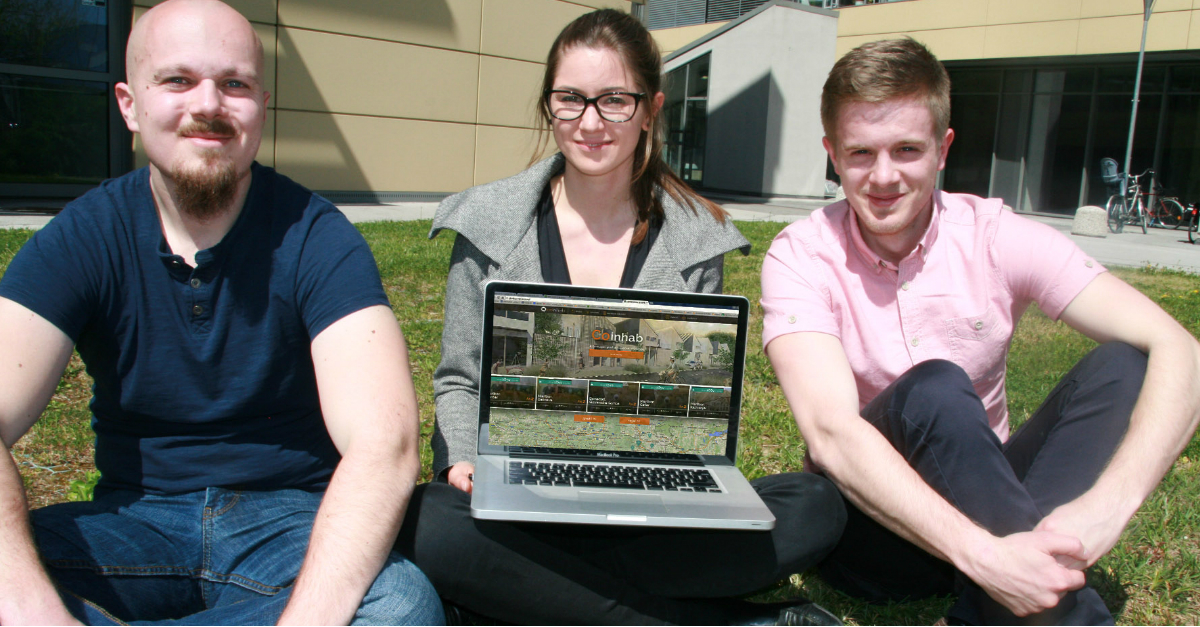
Coinhab is a platform for collective construction, where the builders connect and thus save up to 30 % in construction costs. The team wishes to solve the severe problem of overly expensive apartments, especially in urban centres and their vicinity, which became nearly completely unobtainable for the middle class.
Their solution connects people searching for apartments/builders, architects, and real estate agencies. This way, apartment seekers/builders get a cheaper home, architects get access to larger collective projects, and real estate agencies have the option of selling bigger real estate that’s hard to sell during an economic crisis. Company’s customers are apartment seekers/builders, and architects.
They are carrying out pilot projects in Slovenia, and this year, they will expand the platform to Austria, where they detected a lot of interest. In 2016, they are planning their presence in central Europe, more specifically in Germany, Switzerland and the Netherlands. They currently have a team of future builders who are helping them find an opportunity for realising a project worth approximately 500,000 EUR. Several dozen individuals who wish to collectively build with Coinhab have applied. They also have the first customers for idea projects and have made plans for collaboration with several real estate agencies and architects across Europe. They are in the phase of looking for seed capital as well as talking with investors who could provide seed capital for breakthrough to markets abroad.
Their primary competitors are developer agencies (companies investing and building a neighbourhood and then selling it piece by piece) and construction companies that are building expensive apartments for the market. People building on their own are also competitors, but while this type of construction does offer a high level of personalization, it’s also expensive, risky and time-consuming.
The team believes that they are better than the competition because of their significantly lower construction prices and because apartment seekers/builders at Coinhab can also adapt the apartments to customers’ own wishes.
Team members: Taja Benčina, Jure Škorc, Leon Novak, Marko Orel, Aleš Zorc
5. KRAKEN: silent carbon fins
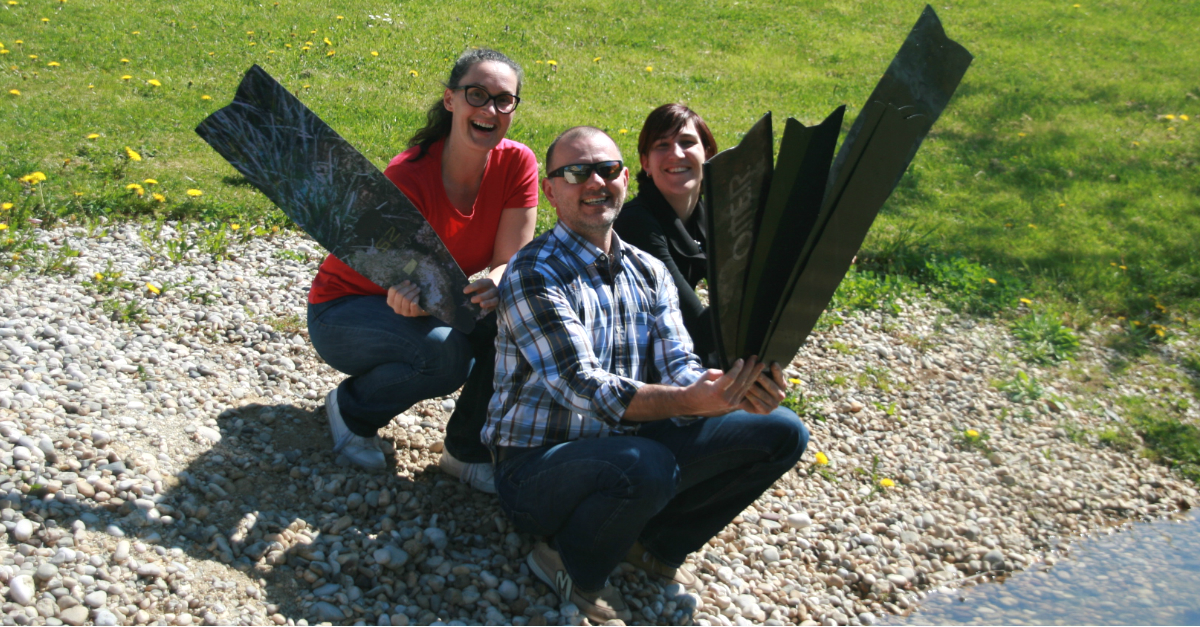
Constructor, innovator and successful entrepreneur Maks Robinik and the Kraken team are presenting the first silent carbon fins in the world, used for first-rate underwater fishing as well as for freediving. The fins are completely silent and give the swimmer 40 % more power efficiency, but they still have the characteristics of preceding fins. The ideal clients are underwater fishermen and apneists who spend a lot of time in the sea, are physically superior (concerning their diving abilities), make really good catches and are incredibly devoted to sport diving and fishing.
The entire global market has 26 million divers and snorkelers. The market value of North America and Europe is 20 billion dollars. They will first penetrate into the market of seaside countries of Southeast Europe and conquer five continents with their products in five years. While competition does exist, they will be different with the only patented silent carbon fins, with which each diver will become a silent explorer. Personalized fins will also be available and, in the future, fins from natural materials as well.
Silent fins have been successfully tested, amongst others by Umberto Pelizzari, multiple world and European champion in freediving, which is something the Kraken team is especially proud of. This year, they will continue the development, testing and activity on their website. In 2016, they are planning to focus on accelerating sales, marketing and building an online store. Afterwards, they will penetrate into the market of Southeast Europe and, by 2020, into global markets. The goal of the Kraken team is to penetrate into five continents in five years.
Team members: Maks Robinik, Gregor Ostojić
6. PLASMADIS: LOKS – plasma diagnostics
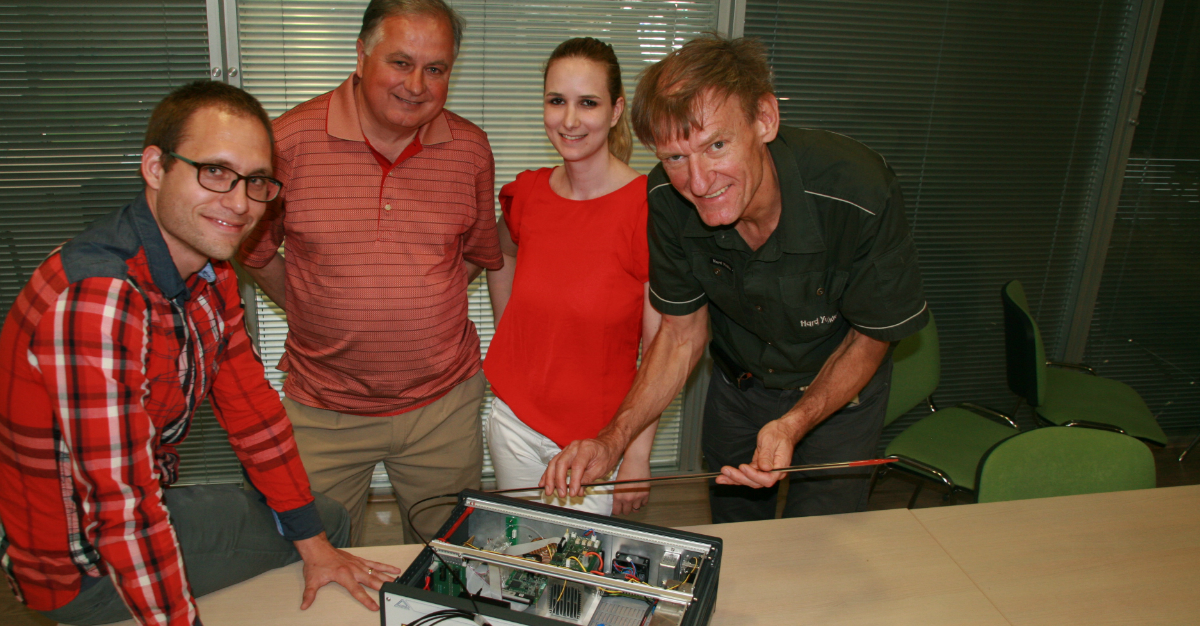
The problem of plasma treatment can be divided into uneven material processing and the creeping of plasma parameters during the treatment process. Both are connected to measuring plasma parameters in real time (atom density). Parameters creeping is especially a problem when making microprocessors, because it impacts their quality.
The solution is a device called the Laser Optical Catalytic Sensor (Laserski Optični Katalitični Senzor or LOKS). The key property of the sensor is that it measures the process parameter of plasma (atom density) in real time. The fact that the sensor works while the treatment process is active is also important. By optimising the plasma process in the production line, the quality of final products improves and the costs connected to product reject are decreased (approximate improvement of up to 40 % less reject).
The company is currently running for the P2A tender for start-up funding, which will allow them to launch the first commercial product and start sales. Special attention will be given to covering the markets of EU, USA, Japan and Korea, where sales representatives/agents will additionally take care of company business (probably in the beginning of 2017). The first buyers are those who have signed a letter of intent to buy, but also esteemed researchers of universities and institutes abroad that do plasma treatment of materials. Potential clients are also companies in the industry that exploit plasma technologies (automobile, textile, electro, food industry etc.).
Methods of their competitors are either too expensive or too time-consuming or don’t enable in-situ atom density measurement. One of the problems is also their impractical use, especially in case of detecting neutral gas radicals in colder parts of fusion reactors for manufacturing energy or in reactors for behaviour simulation of rocket ship coating. A core advantage of their product lies in the relatively low price and in the plug & measure functionality. The product is small (size of a small suitcase) and enables simple integration of the device with minimal intervention into the industrial process itself.
Team members: Gregor Primc, Miran Mozetič, Kaja Primc, Žuga Brankov, Uroš Cvelbar, Alenka Vesel
7. RGA: »De novo« wheat – and how to fix a species
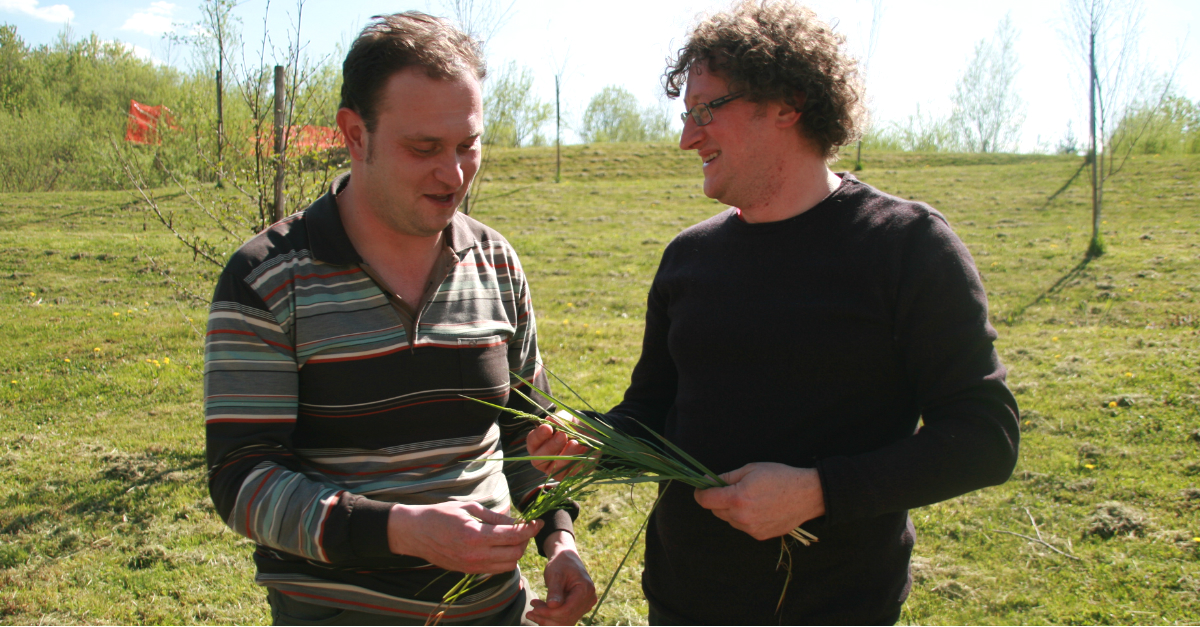
Unique cross-breeding 10,000 years ago led to the wheat we know today – low genetic variability, used genetic potential, low biotic and abiotic stress tolerance. Consequently, the production is stagnating and there is a discrepancy between the supply and the demand.
The solution offered by the team is a repetition of the “de novo” event, but from their own genetic collection with purposefully chosen di- and tetraploid species. The “de novo” procedure exploits heterosis, which is the opposite of inbreeding. There are 120-150 grains in the “de novo” class of wheat species, while there are 30-80 grains in the class of classical species. “De novo” wheat thus gives a 30% better harvest as well as offers better use of the mineral nutrients and higher tolerance for diseases. The team emphasises that this does not fall into the category of genetic engineering or genetically changed organisms.
The wheat market is regional and global, the long-term vision is to enter the global wheat market with better species of wheat and assume at least a 2% market share. They see their target customers in seed companies that also have their own distribution channels. The team is interdisciplinary and they see the advantage of their solution in the market potential (regional and global market), effective protection of intellectual property and the simple scale-up technology.
Team members: Jernej Iskra, Primož Titan, Eva Leopold
8. SBT: tool for risk management Silver Bullet Risk
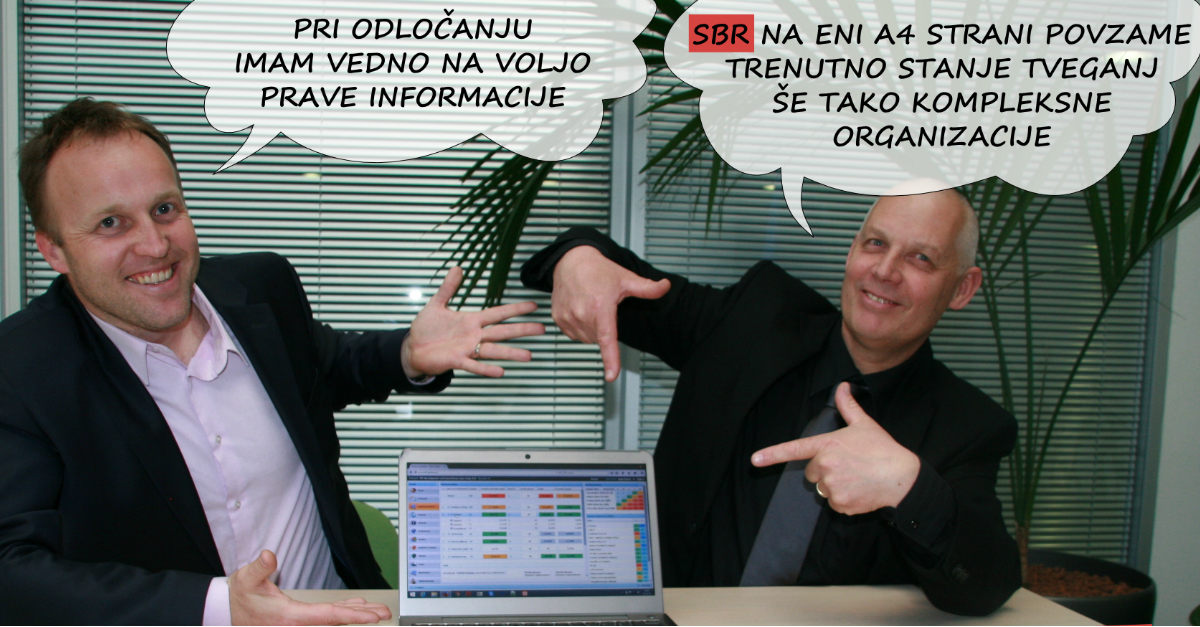
The Silver Bullet Risk team developed a tool for risk management and decision-making that solves the problem of comprehensive risk management in a company, and helps the management lead the company by making better decisions. It gives them information about problems and opportunities that can significantly influence company business. It can prevent a company from ruin or increase EBITDA for 2-3 times.
The problems they’ve identified not only in Slovenia but also in business environments abroad is that the management, administration, supervisory board, owners, internal and external auditors don’t have the entire overview of key risks in the organisation and of possible consequences of management decisions. Risk reports aren’t supported with financial consequences for the organisation itself. Organisations don’t have suitable IT and methodological support in their work, instead mostly using spreadsheets as the only tool for handling risks in the organisation. Thus their work is time-consuming, unclear, it isn’t possible to ensure audit trails and check history, and preparing comprehensive reports based on unified methodology is practically impossible.
The solution is designed for the management, risk managers, owners of business processes and auditors, owners, and the supervisory board, all of which get good insight into the inner functioning of the organization. The team is targeting medium-sized and big companies in EU and the US, and they will first focus on the energy sector.
They currently have 5 buyers, signed contracts – Silver partners (alpha clients), with which they also have a feedback agreement. They are intensively looking for buyers in Slovenia, while at the same time they are setting up a sales system in the D-A-CH region, which will be the key focus next year.
They see the biggest challenge in entering markets abroad and they differ from their competition because they combine all the risks in one place, financially evaluate them, and are quick and easy to install. The team is competent and interdisciplinary, developing innovative algorithms and methodologies. Their goal is to find a strategic partner by June 2016.
Team members: Igor Zgonc, Božo Recko, Luka Ločniškar
9. SNIT: SmartNinja – teaching useful IT skills
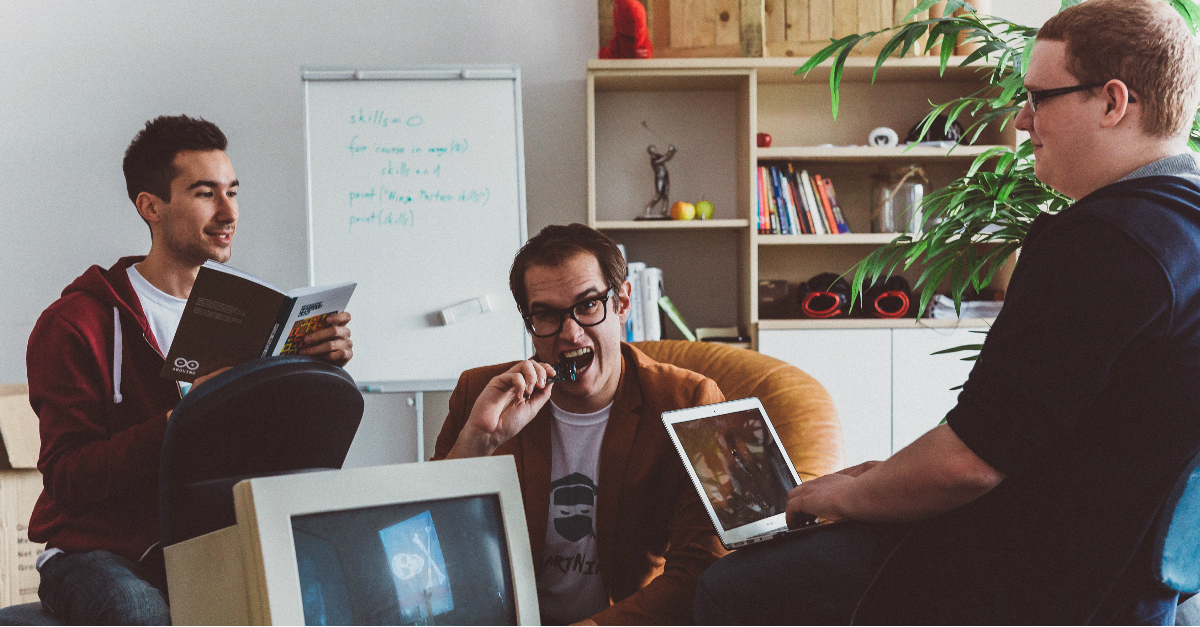
The team uses its solution to decrease the gap between the offer and the demand on the IT job market by organizing courses where they teach people useful IT skills (programming, graphic design, IoT) and help IT companies find new staff. Typical course participants are young people who didn’t study computer sciences but wish to have a career as programmers, and graphic designers who wish to broaden their knowledge as well as entrepreneurs who wish to better understand programmers. Their customers are also IT companies looking for new employees.
The SmartNinja team wishes to expand their courses all over the world, starting with Europe and continuing elsewhere. They mostly see their partners in startup communities and accelerators, but also in international IT companies and foundations. So far, they have trained more than 100 SmartNinjas and signed contracts for organizing courses with IT companies, Microsoft and D.Labs. They are also in the talks for new partnerships and collaborations. They say that they are at the start of their path and vision, but things are unfolding fast and so far successfully. Their mission is to teach useful IT skills.
They are currently developing courses and support software in Slovenia, then they wish to offer their products abroad as well. They aren’t looking for investment capital, they are bootstrapping. They aren’t members of any accelerators, but they are active in the startup community StartUP Novo Mesto.
Their competitors are computer schools and faculties, but the team thinks that those aren’t practical enough and don’t have enough connections with the economy. Their competitors are also various e-learning platforms, but by default, those are less effective than live mentoring, since the latter is more flexible and adapted to the individual. On the other hand, another competitor are also employment agencies that don’t know how to find suitable staff for IT companies.
Team members: Miha Fabjan, Matej Ramuta, Žiga Besal
10.TIBOPO: mDrive – system for supervising bimanual vehicle controls
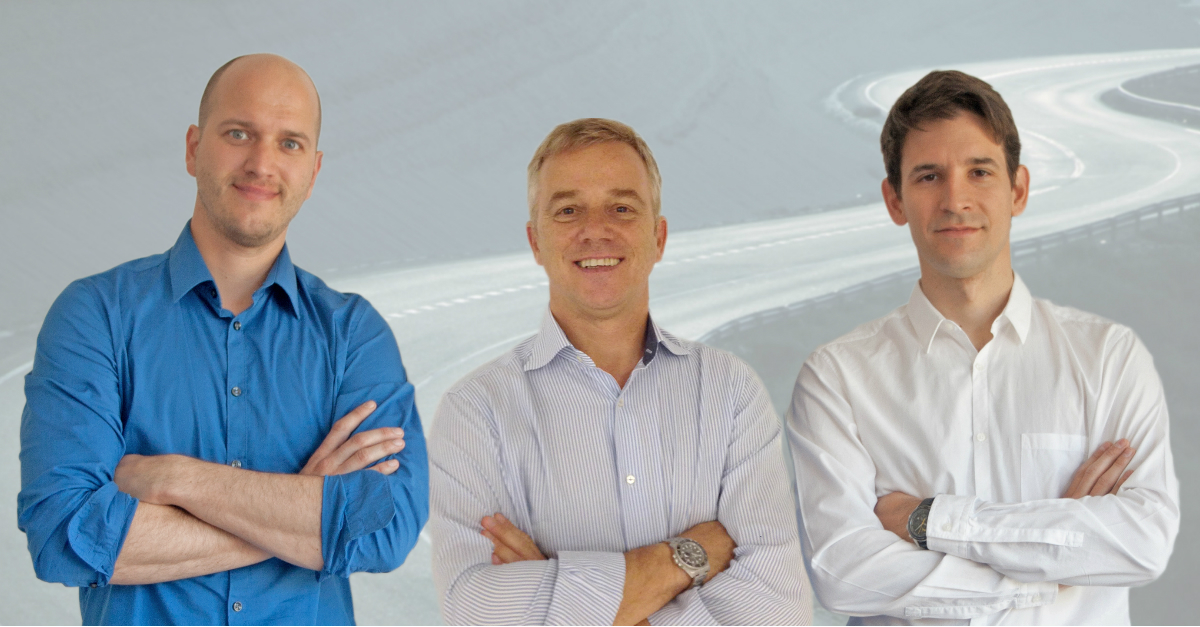
mDrive is an advanced technological system for supervising bimanual vehicle controls. It helps solve an important factor in traffic safety, namely distractions (talking over the phone, writing messages, eating, playing with the radio, fixing one’s looks, for example doing make-up …). The system drastically decreases the possibility of distractions and helps save lives as well as decreases damage.
The test markets are Slovenia and Serbia, followed by Switzerland and Germany. The US is also a target. So far, the team has letters of intent signed by some of the bigger companies that manage a lot of business vehicles. They also have an agreement for the purchase of the first systems, and the Institute of Corporate Security will help them carry out a study concerning the impact of the mDrive system on safe driving.
In the first phase, the team wishes to finish system development and testing. Afterwards, they will actively search for international distribution connections. More capital will also be necessary for fast and efficient penetration. As far as markets abroad are concerned, they already have an agreement with a Serbian company that owns numerous vehicles and is in charge of safety across Serbia.
The product is in competition with two other products in the field of preventing traffic accidents caused by distractions, namely the sensor system of the automobile manufacturer Volvo, called “Eye movement”, and “Attention Assist” by Mercedes. But there are also other products on the market.
Their advantage is retrofitting, since the mDrive system can be installed into any vehicle without interfering with privacy. Other systems have additional deficiencies, such as the use of sunglasses, the inability to sense key distractions and a high price. This is why the mDrive system is a unique solution for increased traffic safety.
Team members: Luka Kreitmayer, Andrej Podvršič, Simon Dobrišek, Janez Perš, Aleš Merčun, Janez Mesarič
The evaluation criteria
Start-up teams that submitted the form for the Start:up Slovenia 2015 competition and the P2 tender of the Slovene Enterprise fund, and pitched at demo days on 9 and 10 April, were evaluated in line with the so-called lean methodologies. We changed the evaluation criteria and evaluated the start-ups according to six key criteria:
- Assessment of the team’s potential and competence
- Understanding the problem
- Solution, unique value proposition, unfair advantage
- Customer segment and channels
- Revenue streams, costs and key metrics
- Personal presentation.
The ten best ranked startups made it into the semi-finals of Start:up Slovenia 2015. Recently, we organised another round of personal pitches in front of a special expert committee that chose five best Slovenian startup companies – five competition finalists that will be revealed at the PODIM press conference on Wednesday, 13 May at 11 o’clock. We will announce which of the finalists will receive a crystal statue, the flattering title “Slovenian Start-up of the Year 2015” and other awards at the evening ceremony, thus triumphantly concluding the first day of the PODIM conference for the eighth year in a row.
All ten teams that made it into the semi-finals of the competition Start:up Slovenia based on demo days assessments are listed in alphabetical order:
1. BITNOT: Unlocking doors handsfree

The BITNOT team developed a method of handsfree unlocking, where a smartphone is used instead of a key. Their solution should prevent unpleasant and stressful situations when people forget their keys or they stand in front of their door while searching for the keys in big purses or bags. The solution is attached to a lock and when the individual approaches the door, the lock detects the mobile phone and unlocks.
The team sees its potential in the increasingly bigger accessibility and use of smartphones as well as in the big sales market of smart locks that will probably be worth around 3.6 billion dollars in 2019. The market of handsfree locks is still in the early stages. There aren’t a lot of competitors and the ones that do exist have one weakness – their solutions aren’t suitable for the European market.
Currently 20 users are testing the product, which is still being improved, because the team wishes to make the installation simpler and increase energy efficiency. They are planning for the battery to withstand being unlocked up to 3000 times. In the future, they are planning to support the Cota wireless charging system, with which battery charging will be simply forgotten. The team is planning a Kickstarter campaign in December, and to start sales in 2016.
Team members: Martin Koterle, Kristjan Ugrin
2. BIZSTART 86: Fluoro detector preventing contamination in laboratories

Contaminated lab equipment can cause wrong results and consequently additional costs because analyses have to be redone. The team sees the solution in a fluoro detector that could examine the equipment and detect any irregularities or impurities before doing the lab analysis. This would save time as well as money. The fluoro detector is thus a niche product in the form of a lab lamp and their solution is suitable for every laboratory doing fluorescence-based research.
The core competency is a complete market innovation and has a large global and market potential. The team is targeting the Slovenian market (also test market), the European and the global market (USA, Brazil, which is also a test market). The product doesn’t have any competition and is the first of its kind on the market. The early users will mostly be research labs in the fields of pharmacy, biochemistry, food industry, medicine, veterinary science…
This year, they are planning to further develop and test the product with customers (Slovenia, Brazil) as well as to plan sales in 2016 (domestic and EU market, entering the global market by the end of 2016).
Team members: Tina Šmuc, Andraž Balkovec, Robi Kopač, Henning Ulrich
3. INOVINE: MagYeast, solution for quick production of sparkling wine

Production of high quality sparkling wines is demanding, expensive, time-consuming and inflexible, which is why excellent producers often face problems related to processing orders on time and delivering their sparkling wines to final clients. At the same time, producing high-quality sparkling wines can be an incredibly profitable activity that had the highest global growth in the beverage production industry in the past decade.
Company InoVine recognized its potential and opportunity mostly in shortening the time-consuming procedure of disgorging, which is a prerequisite for selling sparkling wines on the market. They have created an innovative solution for quick magnet separation of lees from the bottle, which shortens this procedure from a couple of weeks to mere 30 minutes.
This is the innovative solution MagYeast that can revolutionize the process of sparkling wine production, is environmentally-friendly, easy to use and doesn’t interfere with the final quality of sparkling wines. With simple integration into the production process, it saves sparkling wine producers time and money, and consequently increases the profitability and scope of their production.
Their potential clients are excellent global producers of high-quality sparkling wines, with whom the company already established contact, as well as other producers who wish to produce high-quality sparkling wines but currently produce sparkling wines of lower quality due to high production costs. Consequently they reach lower prices on the market and are mostly suitable for sales on the local market.
The company wants to obtain the position as an internationally established provider of high-tech solutions in the field of process engineering in beverage production. Their short-term goal is the development and commercialization of the MagYeast solution, which will be tested by early users this year already. For 2016, they plan to start marketing the solution, starting with the local and regional market, and expanding to the main global markets of sparkling wine a year later.
Team members: Marin Berovič, Uroš Pečaver, Sašo Gyergyek, Milan Vitas
4. KOINHAB: Coinhab – platform for collective construction

Coinhab is a platform for collective construction, where the builders connect and thus save up to 30 % in construction costs. The team wishes to solve the severe problem of overly expensive apartments, especially in urban centres and their vicinity, which became nearly completely unobtainable for the middle class.
Their solution connects people searching for apartments/builders, architects, and real estate agencies. This way, apartment seekers/builders get a cheaper home, architects get access to larger collective projects, and real estate agencies have the option of selling bigger real estate that’s hard to sell during an economic crisis. Company’s customers are apartment seekers/builders, and architects.
They are carrying out pilot projects in Slovenia, and this year, they will expand the platform to Austria, where they detected a lot of interest. In 2016, they are planning their presence in central Europe, more specifically in Germany, Switzerland and the Netherlands. They currently have a team of future builders who are helping them find an opportunity for realising a project worth approximately 500,000 EUR. Several dozen individuals who wish to collectively build with Coinhab have applied. They also have the first customers for idea projects and have made plans for collaboration with several real estate agencies and architects across Europe. They are in the phase of looking for seed capital as well as talking with investors who could provide seed capital for breakthrough to markets abroad.
Their primary competitors are developer agencies (companies investing and building a neighbourhood and then selling it piece by piece) and construction companies that are building expensive apartments for the market. People building on their own are also competitors, but while this type of construction does offer a high level of personalization, it’s also expensive, risky and time-consuming.
The team believes that they are better than the competition because of their significantly lower construction prices and because apartment seekers/builders at Coinhab can also adapt the apartments to customers’ own wishes.
Team members: Taja Benčina, Jure Škorc, Leon Novak, Marko Orel, Aleš Zorc
5. KRAKEN: silent carbon fins

Constructor, innovator and successful entrepreneur Maks Robinik and the Kraken team are presenting the first silent carbon fins in the world, used for first-rate underwater fishing as well as for freediving. The fins are completely silent and give the swimmer 40 % more power efficiency, but they still have the characteristics of preceding fins. The ideal clients are underwater fishermen and apneists who spend a lot of time in the sea, are physically superior (concerning their diving abilities), make really good catches and are incredibly devoted to sport diving and fishing.
The entire global market has 26 million divers and snorkelers. The market value of North America and Europe is 20 billion dollars. They will first penetrate into the market of seaside countries of Southeast Europe and conquer five continents with their products in five years. While competition does exist, they will be different with the only patented silent carbon fins, with which each diver will become a silent explorer. Personalized fins will also be available and, in the future, fins from natural materials as well.
Silent fins have been successfully tested, amongst others by Umberto Pelizzari, multiple world and European champion in freediving, which is something the Kraken team is especially proud of. This year, they will continue the development, testing and activity on their website. In 2016, they are planning to focus on accelerating sales, marketing and building an online store. Afterwards, they will penetrate into the market of Southeast Europe and, by 2020, into global markets. The goal of the Kraken team is to penetrate into five continents in five years.
Team members: Maks Robinik, Gregor Ostojić
6. PLASMADIS: LOKS – plasma diagnostics

The problem of plasma treatment can be divided into uneven material processing and the creeping of plasma parameters during the treatment process. Both are connected to measuring plasma parameters in real time (atom density). Parameters creeping is especially a problem when making microprocessors, because it impacts their quality.
The solution is a device called the Laser Optical Catalytic Sensor (Laserski Optični Katalitični Senzor or LOKS). The key property of the sensor is that it measures the process parameter of plasma (atom density) in real time. The fact that the sensor works while the treatment process is active is also important. By optimising the plasma process in the production line, the quality of final products improves and the costs connected to product reject are decreased (approximate improvement of up to 40 % less reject).
The company is currently running for the P2A tender for start-up funding, which will allow them to launch the first commercial product and start sales. Special attention will be given to covering the markets of EU, USA, Japan and Korea, where sales representatives/agents will additionally take care of company business (probably in the beginning of 2017). The first buyers are those who have signed a letter of intent to buy, but also esteemed researchers of universities and institutes abroad that do plasma treatment of materials. Potential clients are also companies in the industry that exploit plasma technologies (automobile, textile, electro, food industry etc.).
Methods of their competitors are either too expensive or too time-consuming or don’t enable in-situ atom density measurement. One of the problems is also their impractical use, especially in case of detecting neutral gas radicals in colder parts of fusion reactors for manufacturing energy or in reactors for behaviour simulation of rocket ship coating. A core advantage of their product lies in the relatively low price and in the plug & measure functionality. The product is small (size of a small suitcase) and enables simple integration of the device with minimal intervention into the industrial process itself.
Team members: Gregor Primc, Miran Mozetič, Kaja Primc, Žuga Brankov, Uroš Cvelbar, Alenka Vesel
7. RGA: »De novo« wheat – and how to fix a species

Unique cross-breeding 10,000 years ago led to the wheat we know today – low genetic variability, used genetic potential, low biotic and abiotic stress tolerance. Consequently, the production is stagnating and there is a discrepancy between the supply and the demand.
The solution offered by the team is a repetition of the “de novo” event, but from their own genetic collection with purposefully chosen di- and tetraploid species. The “de novo” procedure exploits heterosis, which is the opposite of inbreeding. There are 120-150 grains in the “de novo” class of wheat species, while there are 30-80 grains in the class of classical species. “De novo” wheat thus gives a 30% better harvest as well as offers better use of the mineral nutrients and higher tolerance for diseases. The team emphasises that this does not fall into the category of genetic engineering or genetically changed organisms.
The wheat market is regional and global, the long-term vision is to enter the global wheat market with better species of wheat and assume at least a 2% market share. They see their target customers in seed companies that also have their own distribution channels. The team is interdisciplinary and they see the advantage of their solution in the market potential (regional and global market), effective protection of intellectual property and the simple scale-up technology.
Team members: Jernej Iskra, Primož Titan, Eva Leopold
8. SBT: tool for risk management Silver Bullet Risk

The Silver Bullet Risk team developed a tool for risk management and decision-making that solves the problem of comprehensive risk management in a company, and helps the management lead the company by making better decisions. It gives them information about problems and opportunities that can significantly influence company business. It can prevent a company from ruin or increase EBITDA for 2-3 times.
The problems they’ve identified not only in Slovenia but also in business environments abroad is that the management, administration, supervisory board, owners, internal and external auditors don’t have the entire overview of key risks in the organisation and of possible consequences of management decisions. Risk reports aren’t supported with financial consequences for the organisation itself. Organisations don’t have suitable IT and methodological support in their work, instead mostly using spreadsheets as the only tool for handling risks in the organisation. Thus their work is time-consuming, unclear, it isn’t possible to ensure audit trails and check history, and preparing comprehensive reports based on unified methodology is practically impossible.
The solution is designed for the management, risk managers, owners of business processes and auditors, owners, and the supervisory board, all of which get good insight into the inner functioning of the organization. The team is targeting medium-sized and big companies in EU and the US, and they will first focus on the energy sector.
They currently have 5 buyers, signed contracts – Silver partners (alpha clients), with which they also have a feedback agreement. They are intensively looking for buyers in Slovenia, while at the same time they are setting up a sales system in the D-A-CH region, which will be the key focus next year.
They see the biggest challenge in entering markets abroad and they differ from their competition because they combine all the risks in one place, financially evaluate them, and are quick and easy to install. The team is competent and interdisciplinary, developing innovative algorithms and methodologies. Their goal is to find a strategic partner by June 2016.
Team members: Igor Zgonc, Božo Recko, Luka Ločniškar
9. SNIT: SmartNinja – teaching useful IT skills

The team uses its solution to decrease the gap between the offer and the demand on the IT job market by organizing courses where they teach people useful IT skills (programming, graphic design, IoT) and help IT companies find new staff. Typical course participants are young people who didn’t study computer sciences but wish to have a career as programmers, and graphic designers who wish to broaden their knowledge as well as entrepreneurs who wish to better understand programmers. Their customers are also IT companies looking for new employees.
The SmartNinja team wishes to expand their courses all over the world, starting with Europe and continuing elsewhere. They mostly see their partners in startup communities and accelerators, but also in international IT companies and foundations. So far, they have trained more than 100 SmartNinjas and signed contracts for organizing courses with IT companies, Microsoft and D.Labs. They are also in the talks for new partnerships and collaborations. They say that they are at the start of their path and vision, but things are unfolding fast and so far successfully. Their mission is to teach useful IT skills.
They are currently developing courses and support software in Slovenia, then they wish to offer their products abroad as well. They aren’t looking for investment capital, they are bootstrapping. They aren’t members of any accelerators, but they are active in the startup community StartUP Novo Mesto.
Their competitors are computer schools and faculties, but the team thinks that those aren’t practical enough and don’t have enough connections with the economy. Their competitors are also various e-learning platforms, but by default, those are less effective than live mentoring, since the latter is more flexible and adapted to the individual. On the other hand, another competitor are also employment agencies that don’t know how to find suitable staff for IT companies.
Team members: Miha Fabjan, Matej Ramuta, Žiga Besal
10.TIBOPO: mDrive – system for supervising bimanual vehicle controls

mDrive is an advanced technological system for supervising bimanual vehicle controls. It helps solve an important factor in traffic safety, namely distractions (talking over the phone, writing messages, eating, playing with the radio, fixing one’s looks, for example doing make-up …). The system drastically decreases the possibility of distractions and helps save lives as well as decreases damage.
The test markets are Slovenia and Serbia, followed by Switzerland and Germany. The US is also a target. So far, the team has letters of intent signed by some of the bigger companies that manage a lot of business vehicles. They also have an agreement for the purchase of the first systems, and the Institute of Corporate Security will help them carry out a study concerning the impact of the mDrive system on safe driving.
In the first phase, the team wishes to finish system development and testing. Afterwards, they will actively search for international distribution connections. More capital will also be necessary for fast and efficient penetration. As far as markets abroad are concerned, they already have an agreement with a Serbian company that owns numerous vehicles and is in charge of safety across Serbia.
The product is in competition with two other products in the field of preventing traffic accidents caused by distractions, namely the sensor system of the automobile manufacturer Volvo, called “Eye movement”, and “Attention Assist” by Mercedes. But there are also other products on the market.
Their advantage is retrofitting, since the mDrive system can be installed into any vehicle without interfering with privacy. Other systems have additional deficiencies, such as the use of sunglasses, the inability to sense key distractions and a high price. This is why the mDrive system is a unique solution for increased traffic safety.
Team members: Luka Kreitmayer, Andrej Podvršič, Simon Dobrišek, Janez Perš, Aleš Merčun, Janez Mesarič



